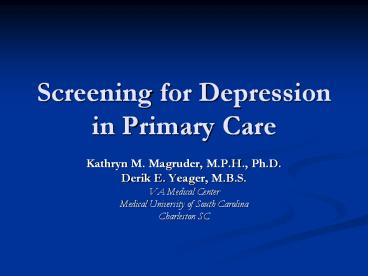Screening for Depression in Primary Care - PowerPoint PPT Presentation
1 / 28
Title:
Screening for Depression in Primary Care
Description:
Screening for Depression in Primary Care. Kathryn M. Magruder, M.P.H., Ph.D. Derik E. Yeager, M.B.S. VA Medical Center. Medical University of South Carolina – PowerPoint PPT presentation
Number of Views:305
Avg rating:3.0/5.0
Title: Screening for Depression in Primary Care
1
Screening for Depression in Primary Care
- Kathryn M. Magruder, M.P.H., Ph.D.
- Derik E. Yeager, M.B.S.
- VA Medical Center
- Medical University of South Carolina
- Charleston SC
2
Overview
- Epidemiology of depression in primary care
- Which screening tool should be used?
- Implementing depression screening in primary care
- What developments are on the horizon?
- Conclusions
3
Epidemiology1. Population Prevalence
- NCS-R DSM-IV dx (12 month prevalence)
- 9.5 any mood disorder
- 6.7 MDD
- 19.5 mild
- 50.1 moderate
- 30.4 serious
- 1.5 dysthymia
- European 6-country study (12 month prevalence)
- MDD 3.9
- European meta-analysis (27 studies) (12 month
prevalence) - MDD 3.1-10.1
4
Epidemiology2. Primary Care Prevalence
- Pre-DSM-III-R PC MDD prevalence 4.8-8.6
- WHO PPGHC (15 cities/14 countries) MDD (ICD10)
10.4 (2.6-29.5) - Backenstrass et al. (2006)
- 4.6 MDD
- 6.2 minor depression
- 9.1 nonspecific depression sx
5
Primary CareThe de facto MH System
- ECA MDD (12 months prior)
- 45 any health service
- 27.8 specialty mental health care
- 25.3 general medical sector
- NCS-R MDD (12 months prior)
- 51.6 any health service
- 27.2 general medical sector
- 12.8 classified as mild
- 50-80 of all depression management in PC
6
Recognition of DepressionThe Primary Care Irony
- General medical settings primary venue for
treating depression (and other mental disorders) - lt50 with MDD are diagnosed in PC
- Magruder et al. VA sample of 819 52 correct dx
of depression (MDD, NOS, dysthymia) - WHO PPGHS 54.2 (range 19.3-74.0) with
depression correctly recognized as having
psychological illness
7
Which Screening Tool?1. Standard Screeners
8
Which Screening Tool?2. Short Screeners
9
Which Screening Tool?3. Ultra-Short/Ultra-Brief
Screeners
10
Two-stage Approaches
- Combine screening and diagnosis
- Quick screen (stem questions)
- Dx modules for screen patients
- SDDS-PC
- PRIME-MD
11
Screening for General Emotional Distress
12
Screening for Multiple Disorders
- General screener 1-2 items/disorder
- Anxiety Depression Detector (ADD)
(Means-Christensen et al., 2006) 5 questions - Panic d/o
- PTSD
- Social phobia
- GAD
- MDD
13
Severity Ratings
- Beyond case-finding
- Evaluate treatment response/effectiveness
- Helps with watchful waiting for at risk
patients with subthreshold or minor depression - Administer screeners repeatedly
- Sx changes
- Examples
- Zung SDS
- PHQ-9
14
Implementing Screeningin Primary Care
- Consider
- Screening instrument performance characteristics
- Clinical context
- Underlying non-psychiatric case-mix
- Overall staffing patterns
- Underling prevalence of depression
- With above parameters, can estimate resource use
for various implementation strategies
15
1-Stage Screening Approach 5 Prevalence80
Sensitivity, 80 Specificity
16
1-Stage Screening Approach 10 Prevalence80
Sensitivity, 80 Specificity
17
1-Stage Screening Approach 20 Prevalence80
Sensitivity, 80 Specificity
18
Performance of a One-Stage Screening Approach
Sample size 1000 Sensitivity 80 Specificity
80
19
2-Stage Screening Approach 5 Prevalence
20
2-Stage Screening Approach 10 Prevalence
21
2-Stage Screening Approach 20 Prevalence
22
Performance of a Two-Stage Screening Approach
Sample size 1000 Sensitivity 95 (Stage I) 80
(Stage II) Specificity 60 (Stage I) 80 (Stage
II)
23
Screening Burden by Task
24
Single Stage Screening Approach (Sensitivity
80, Specificity 80)
25
Two Stage Screening Approach Stage I
(Sensitivity 95, Specificity 60) Stage II
(Sensitivity 80, Specificity 80)
Stage I
Stage II
26
Comparison of Patient, Staff, and Provider Time
(min) for One and Two Stage Screeners
27
What Developments Are on the Horizon?
- Increasing acceptance of screening (USPSTF)
- Reduce stigma
- Improve screening benefit/cost ratio
- Improve tx outcomes
- Reduce screening time
- Reduce clinician and staff time by modifying
screening modality - Patient self-administered computerized screens
- Automated EMR screening reminders
- 2-stage screening process
- Dedicated nurses for screening dx (also
case-management) - Screening for multiple psychiatric disorders
- Screening less often (e.g., 2-5 years instead of
every year)
28
Conclusions
- Improvements in depression screening have
paralleled improvements in depression treatment
and reduced stigma - PCPs have embraced responsibility for screening,
recognizing, and treating depression - For additional efficiencies, we will need
- Advances in technology (e.g., computerized
screening and scoring) - Improved tx outcomes































